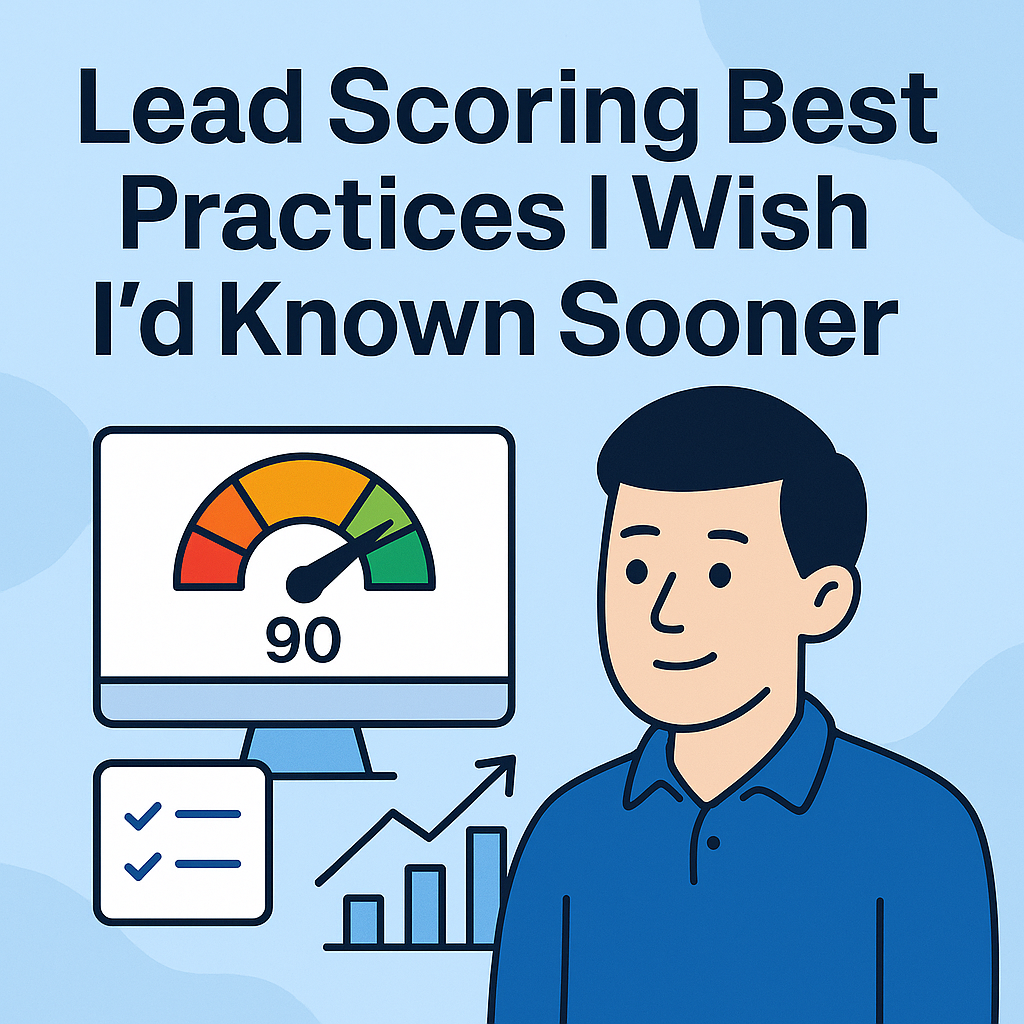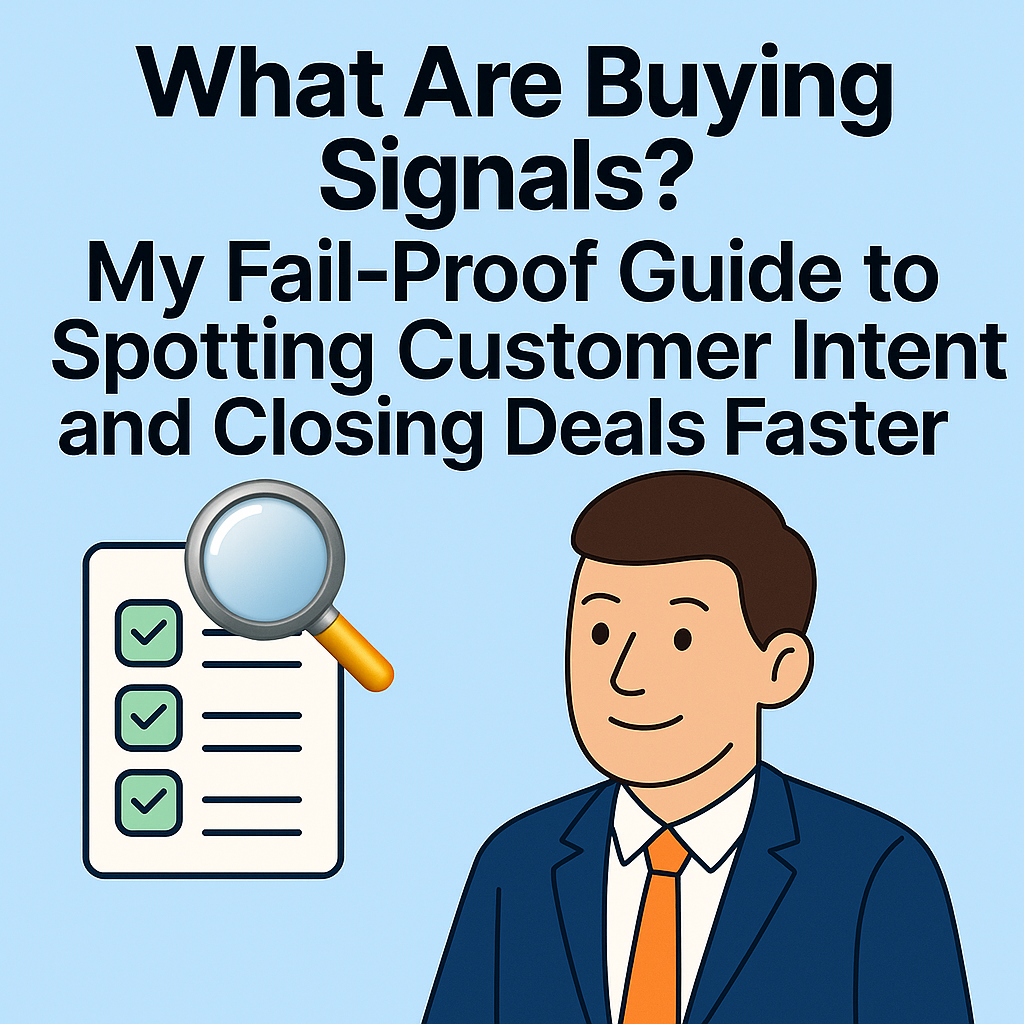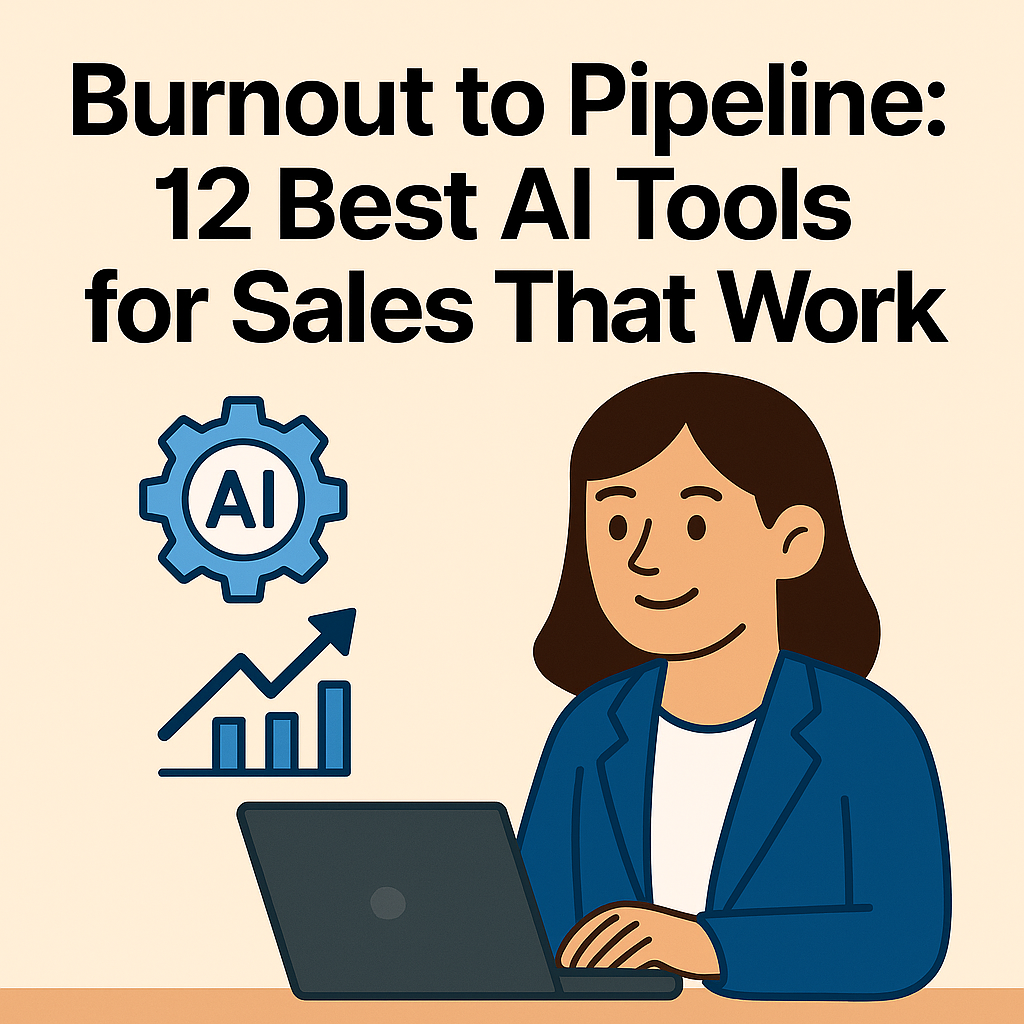9 B2B Lead Generation Strategies I Wish I Knew Sooner (2025)
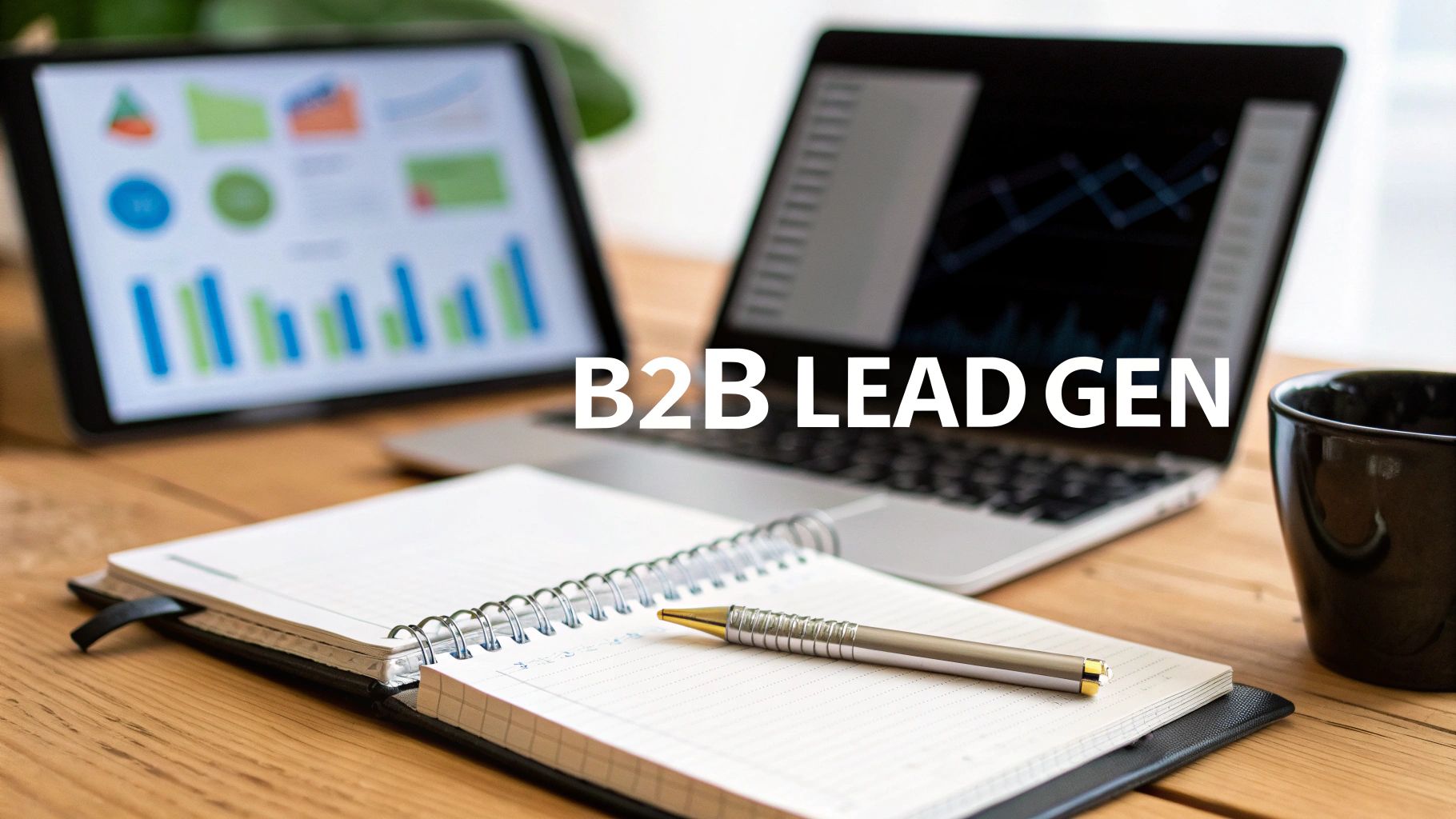
How much time have you wasted pursuing leads that seemed more like ghosts? Let's face it. They fill out a form, open an email, and then disappear. You know the ones. It's costly, infuriating, and a huge drain on team morale.
I know what it's like to spend money on campaigns that only lead to dead-end contacts and question whether high-quality B2B leads are a myth. I still clearly recall a campaign in which we drove traffic to a whitepaper by spending $5,000 on advertisements. We got hundreds of downloads... and not a single qualified meeting. It was a painful, expensive lesson.
The truth is, a pipeline filled with genuinely interested prospects isn't a fantasy. It’s the direct result of a smart, multi-channel approach. The problem isn't a lack of effort; it's often a lack of the right strategies executed with precision. Generic advice like "create great content" is outdated. You need a playbook, not a platitude. Sound familiar?
This isn't just another list of vague ideas. This is a comprehensive breakdown of the most effective B2B lead generation strategies I've used to build and scale revenue engines, filled with the mistakes I made so you don't have to. We're going to move beyond the theory and dive straight into actionable, step-by-step tactics you can implement today.
Get ready to explore everything from leveraging LinkedIn Sales Navigator for hyper-targeted outreach to building powerful Account-Based Marketing (ABM) campaigns that treat key accounts like the VIPs they are. We’ll cover how to run webinars that convert, create referral programs that build momentum, and optimize paid ads to stop burning cash. For each strategy, I'll share what to do and the real-world lessons I learned the hard way. It’s time to stop chasing ghosts and start building a predictable, high-quality lead flow. Let's get to it.
1. Content Marketing & SEO
Content marketing, when paired with a sharp SEO strategy, isn't just about creating blog posts; it's about becoming the definitive answer to your prospect's most urgent questions. This is one of the most powerful b2b lead generation strategies because it pulls prospects toward you by offering genuine value before you ever ask for a sale. Instead of shouting about your product, you’re solving problems, building trust, and establishing your brand as an industry authority.
The core idea is simple: create and distribute valuable, relevant content that your ideal customer is actively looking for. Think blog posts, in-depth whitepapers, data-rich case studies, and helpful videos. When a potential lead finds your content through a search engine and it perfectly addresses their pain point, you’ve initiated a powerful, non-intrusive relationship.
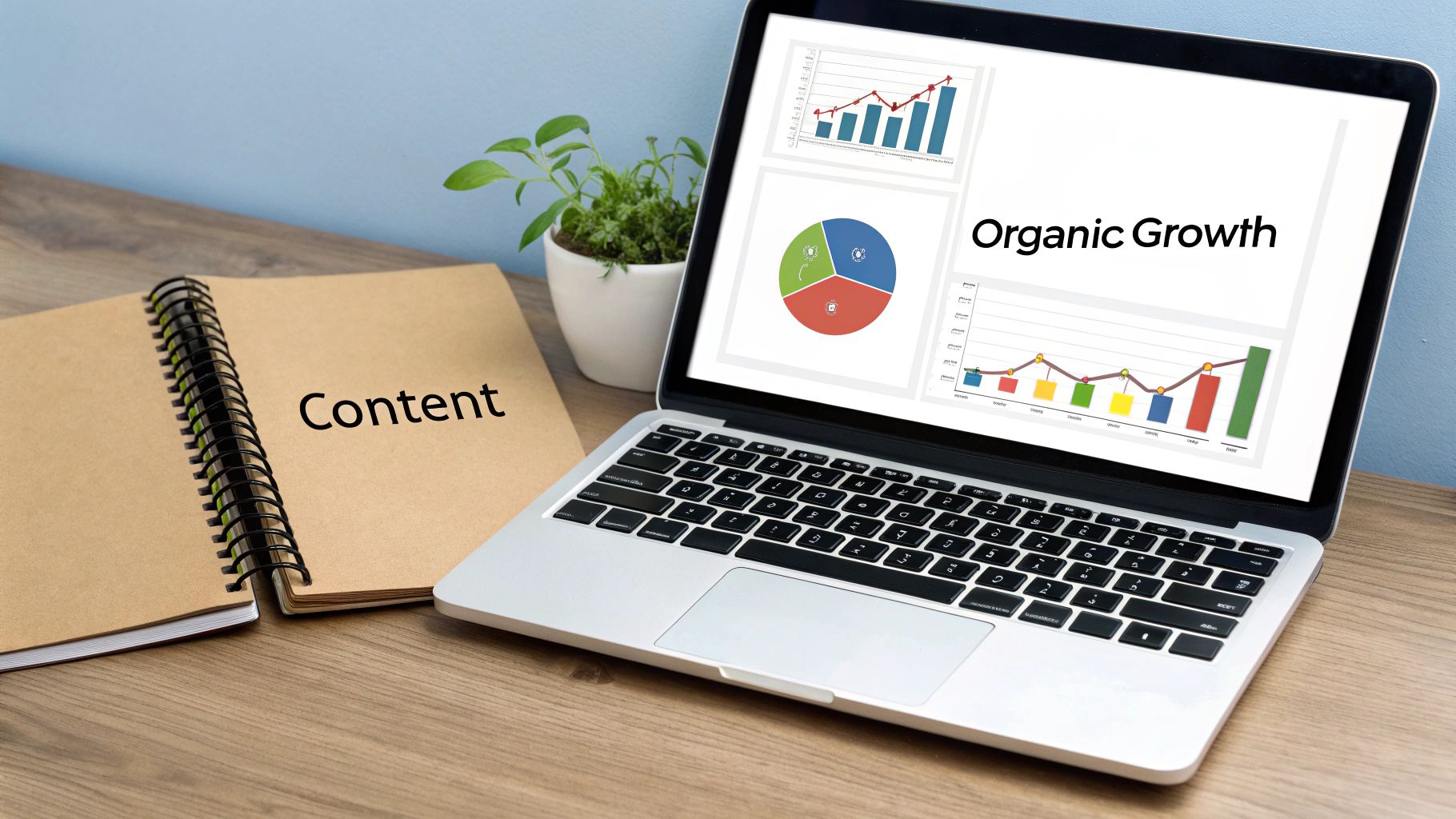
Actionable Steps to Implement This Strategy
So, how do you turn this concept into a lead-generating machine? It’s not as daunting as it sounds. I recall when we first started, we made the classic mistake of writing about what we thought was interesting. Big mistake. 🤦♂️ The game changed when we started listening to what our customers were asking.
Here's a step-by-step approach that works:
- Identify Bottom-of-Funnel (BoFu) Keywords: Start with keywords that signal purchase intent. Think "[Your Service] pricing," "best [Your Product Category] software," or "[Competitor] alternative." These searchers are making a decision. Use a tool like Ahrefs or SEMrush to find these gems.
- Create Topic Clusters: Don't just write one-off posts. Build a "pillar page" on a core topic (e.g., "The Ultimate Guide to B2B Lead Generation") and surround it with "cluster posts" that dive into subtopics (like this article!). This structure signals expertise to Google and keeps readers engaged.
- Develop a High-Value Lead Magnet: Your content attracts visitors; a lead magnet captures them. Offer a compelling resource :a free checklist, an exclusive whitepaper, or a webinar recording, in exchange for their email address. NEVER offer something generic. Make it so good that people would pay for it. Our best-performing lead magnet was a simple spreadsheet template that saved our audience hours of work. It converted at 22%.
- Promote and Repurpose Relentlessly: Your job isn't done when you hit "publish." Share your content on LinkedIn, in newsletters, and on relevant forums. Turn a blog post into a video, a video into a carousel post, and key stats into a tweet thread. Maximize the reach of every single piece you create.
2. LinkedIn Sales Navigator & Social Selling
Forget cold calling and spammy DMs. Social selling on LinkedIn, supercharged by Sales Navigator, is about transforming your sales process from a numbers game into a relationship-building art form. It’s one of the most direct b2b lead generation strategies available because it places you right where your ideal decision-makers are already networking, learning, and sharing. Instead of interrupting, you’re connecting, contributing, and building trust long before you ever mention your product.
The strategy is to leverage LinkedIn's vast professional network to identify the right prospects, understand their needs through their activity, and engage them with valuable insights. When a key executive sees you consistently sharing relevant content and intelligently commenting on their posts, you shift from being a random salesperson to a credible, trusted advisor.
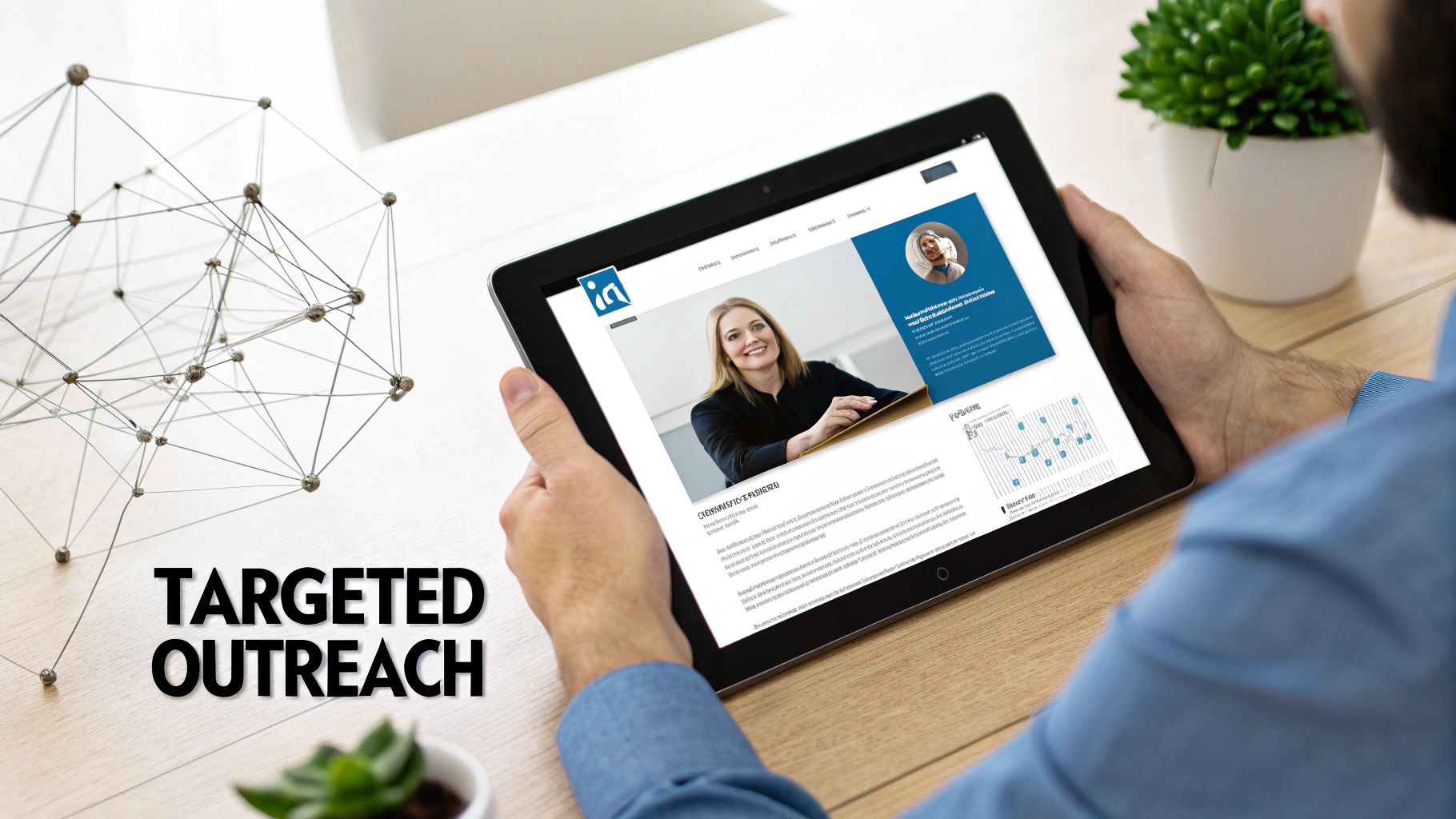
Actionable Steps to Implement This Strategy
So, how do you go from simply having a LinkedIn profile to actually closing deals with it? I used to think sending 100 generic connection requests a day was the key. Wrong. 🤦♀️ It just got my account restricted and annoyed a lot of people. The magic happened when I started treating LinkedIn like a real-life networking event, focusing on quality over quantity.
Here's a step-by-step approach that builds a pipeline:
- Optimize Your Profile for Your Buyer, Not a Recruiter: Your profile is your digital storefront. NEVER make it a resume. Your headline should state how you help your target audience (e.g., "Helping SaaS founders scale MRR with predictable lead flow"). Your "About" section should tell a story that addresses their pain points.
- Build Hyper-Targeted Lead Lists in Sales Navigator: Utilize advanced filters like company size, industry, job function, and "posted on LinkedIn in the last 30 days" to find active, perfect prospects. Save these searches to get alerts when new people fit your criteria. This is your lead-finding machine.
- Engage Before You Connect: Don’t just send a connection request. Follow your key prospects first. For a week, intelligently comment on their posts and share their content. When you finally send the request, your name will already be familiar. Add a personalized note referencing your recent interaction, like, "Hey [Name], loved your post on [topic]. Great point about [X]. Would love to connect."
- Share Value, Don't Pitch: Consistently share insights, industry news, and helpful tips without asking for anything in return. The goal is to be an expert in your niche. When the time is right to pitch, the conversation will be warm and welcoming. A simple post format that works wonders is: "Problem -> My Failed Attempt -> The Solution I Found -> What You Can Learn".
3. Email Marketing & Automation
Email marketing is far from dead; it has simply evolved. When combined with automation, it becomes one of the most effective b2b lead generation strategies for nurturing relationships at scale. This isn't about blasting your entire list with the same generic newsletter. It’s about delivering the right message to the right person at the right moment, guiding them from a curious prospect to a ready-to-buy lead.
The power lies in using data to personalize the journey. By segmenting your audience based on their behavior, interests, and stage in the sales funnel, you can automate sequences that feel personal and are incredibly relevant. Think of it as a digital salesperson working 24/7, educating prospects and building trust while you focus on closing deals.
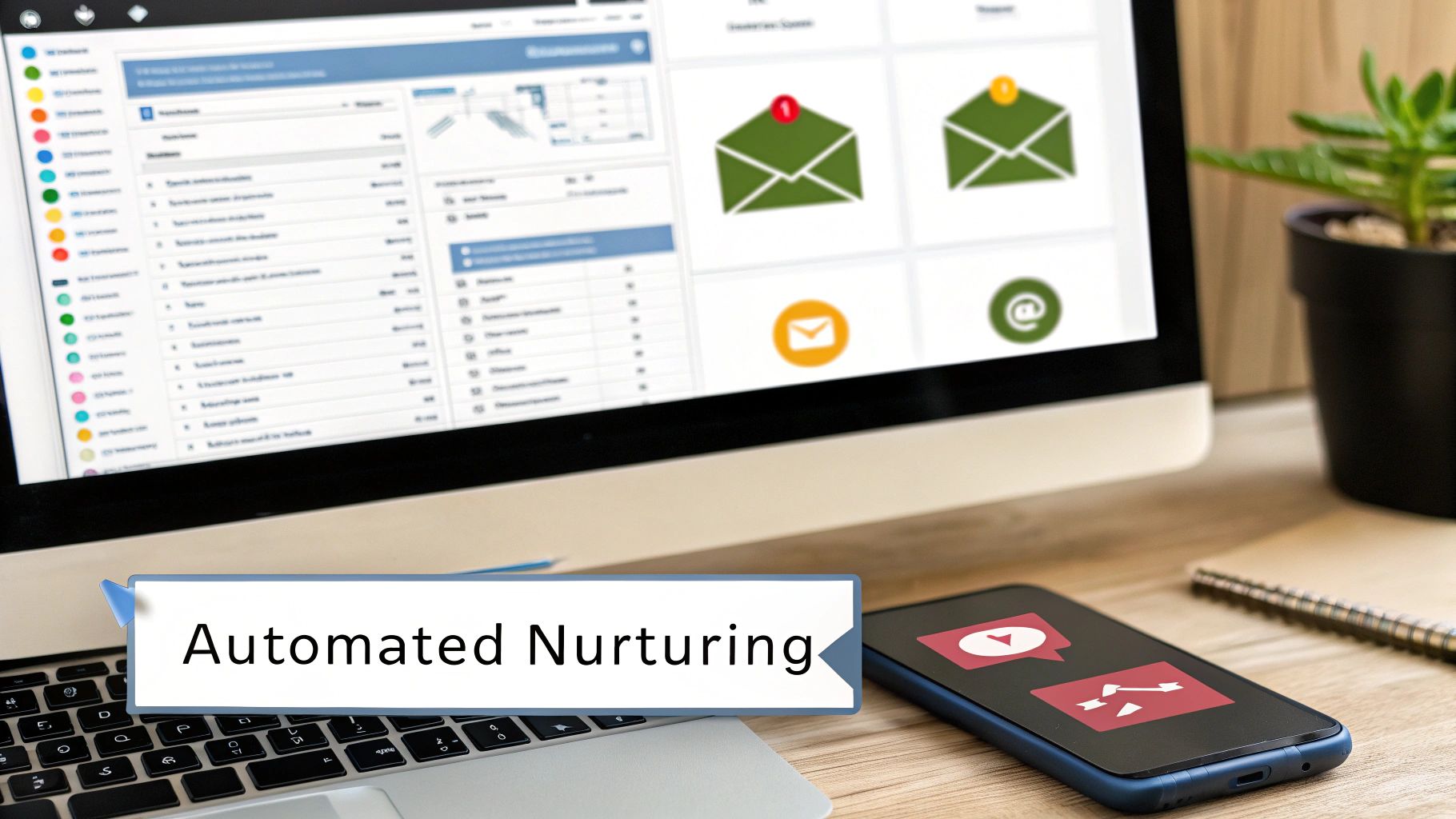
Actionable Steps to Implement This Strategy
How do you build an email machine that doesn't just send emails but generates qualified leads? I’ll be honest, my first attempts were a disaster. 😬 We sent a generic "product update" to everyone and got a 10% unsubscribe rate overnight. The lesson? Personalization and segmentation are everything.
Here's a step-by-step approach to do it right:
- Segment Your List from Day One: Don't wait until you have thousands of contacts. Start segmenting immediately based on how they signed up (e.g., downloading a specific white-paper, attending a webinar, or requesting a demo). This allows for targeted follow-ups.
- Map Out Nurture Sequences: For each segment, create a simple automated email sequence. A "webinar attendee" sequence might include a thank-you email with the recording, a follow-up with a related case study, and finally, an offer for a personalized consultation.
- Craft a "Welcome" Series: Your first impression matters most. Create a 3-5 email welcome series for new subscribers that introduces your brand, provides immense value, sets expectations, and guides them toward a key resource. This builds immediate engagement. Our first email always has a PS that asks, "What's the biggest challenge you're facing with [topic] right now?" The replies are pure gold.
- Focus on a Single, Clear CTA: Every email should have one primary goal. Whether it's to read a blog post, download a resource, or book a call, make the call-to-action (CTA) obvious and singular. NEVER confuse your reader with multiple competing CTAs. Make your CTA button a contrasting color so it pops up on the page.
4. Account-Based Marketing (ABM)
Account-Based Marketing, or ABM, flips the traditional marketing funnel on its head. Instead of casting a wide net and hoping to catch leads, ABM is like laser-guided fishing. You identify your highest-value target accounts first and then dedicate your sales and marketing efforts to winning them over with hyper-personalized campaigns. This is one of the most effective b2b lead generation strategies for high-value deals because it treats individual companies as a "market of one."
The magic of ABM lies in its focus and alignment. Sales and marketing stop working in silos and instead collaborate to surround key decision-makers within a target account with tailored messaging across multiple channels. It’s about quality over quantity, building deep relationships with the accounts that can truly transform your business.
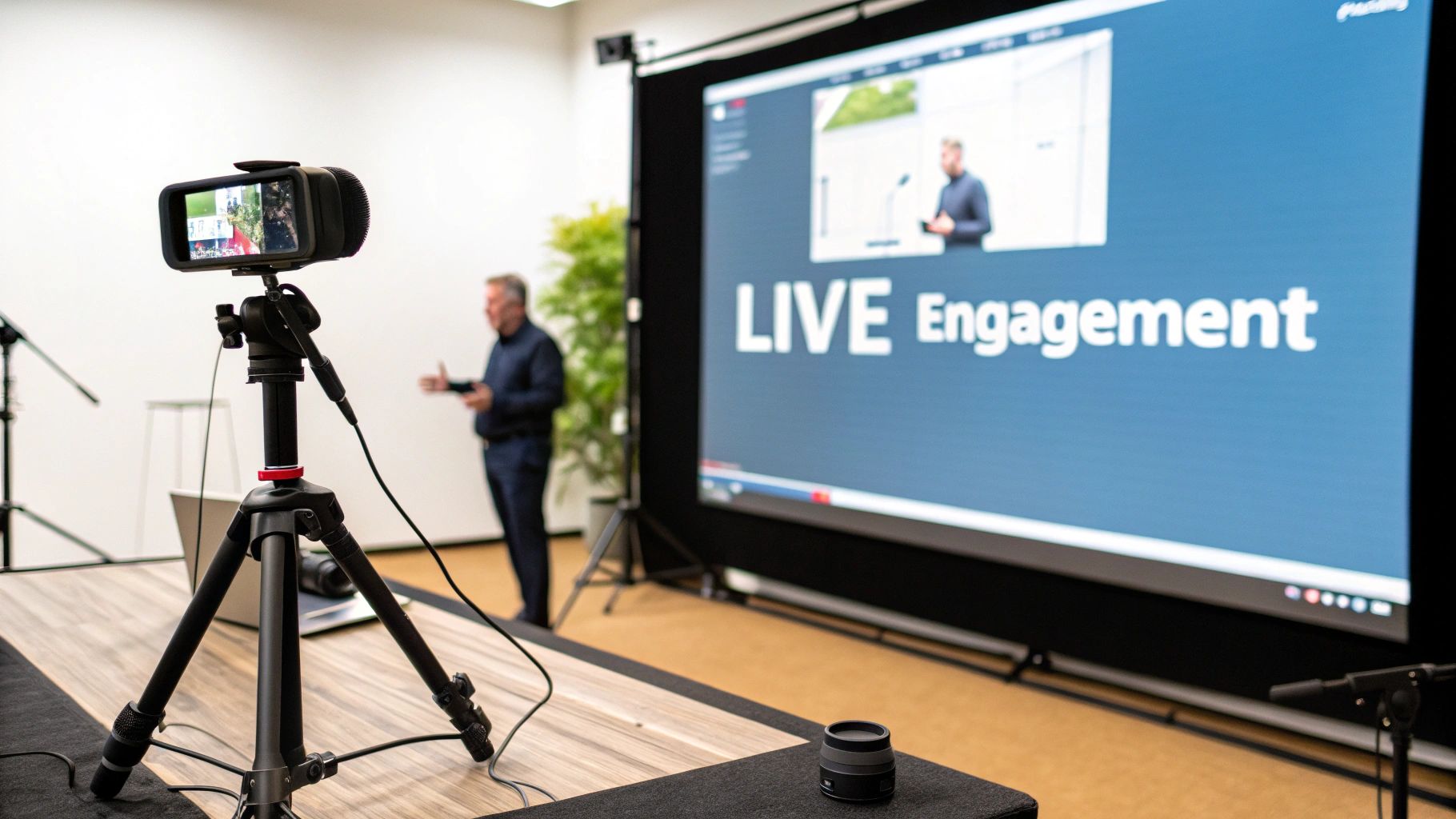
Actionable Steps to Implement This Strategy
So, how do you stop spraying and praying and start targeting with precision? Early on, we tried a "lite" version of ABM, and it fell flat. Why? We didn't get sales and marketing in the same room from day one. 🤦♀️ The strategy only clicked when both teams agreed on the target list and the messaging together.
Here’s a step-by-step approach that drives results:
- Define Your Ideal Customer Profile (ICP) and Tier Your Targets: First, get crystal clear on what your absolute best customers look like. Analyze your current top clients based on revenue, lifetime value, and industry. Then, create a "Tier 1" list of 10-20 dream accounts that perfectly match this profile. These are your non-negotiable targets.
- Align Sales & Marketing Teams (For Real): This isn't just a meeting; it's a pact. Both teams must agree on the target accounts, the key decision-makers within them, the campaign goals, and the messaging. NEVER let marketing run an ABM campaign without deep, continuous involvement from the sales reps who own those accounts.
- Map Accounts and Craft Personalized Plays: For each target company, identify the key players : the champion, the budget holder, the technical buyer. Research their specific pain points and company goals using their annual reports or recent press releases. Then, create personalized content, ads, and outreach sequences that speak to those needs.
- Execute a Multi-Channel, Multi-Touchpoint Campaign: Engage your target accounts at all touchpoints. This could include personalized LinkedIn ads, targeted emails mentioning a recent company achievement, high-value direct mail (like a relevant business book with a handwritten note), and coordinated outreach from your sales team. The goal is to create a seamless, cohesive experience.
5. Webinars and Virtual Events
Webinars are one of the most direct and engaging b2b lead generation strategies you can use. Instead of passively waiting for a lead to read a blog post, you get a captive audience for 45-60 minutes, allowing you to educate, build authority, and interact with them in real-time. This isn’t about a thinly veiled sales pitch; it's a value exchange where you offer expert knowledge in return for a prospect’s time and attention.
The magic of a webinar lies in its interactive format. You’re not just broadcasting information; you’re starting a conversation. Through live Q&A sessions, polls, and chats, you can directly address a prospect's specific pain points and questions, building a much deeper connection than static content ever could. Think of it as a one-to-many sales demo disguised as a free masterclass.
Actionable Steps to Implement This Strategy
So, how do you host a webinar that doesn’t feel like a corporate snooze-fest? I’ve sat through my share of terrible webinars where the host reads from their slides. The secret is to treat it like a live show, not a presentation. It’s about energy and genuine engagement.
Here's a step-by-step approach to make your virtual events a success:
- Pick a Pain-Point-Driven Topic: Don't host a webinar about your product's features. Instead, focus on a problem your ideal customer is desperate to solve. A title like "How to Cut Your Customer Acquisition Cost by 30% in 90 Days" will get far more sign-ups than "A Deep Dive into Our Analytics Platform."
- Promote Like a Launch: A great webinar with no attendees is a waste. Promote it everywhere: on LinkedIn, in your email newsletter, through partner channels, and even with targeted social media ads. Create a sense of urgency with countdowns and "last chance to register" reminders.
- Engage, Don't Just Present: Start with a poll to get the audience involved immediately. Ask questions throughout the presentation and encourage use of the chat. The Q&A at the end is where the real gold is. NEVER rush the Q&A; it's your best opportunity to identify highly qualified leads. I always budget 15-20 minutes just for Q&A.
- Follow Up Fast and Smart: This is where most companies fail. You must follow up with attendees within 24 hours. Segment your list: send one email to those who attended live (with the recording and a special offer) and another to those who registered but didn't show up (with the recording and a "sorry we missed you" note). Automate this process so no lead falls through the cracks.
6. Referral and Partner Programs
Why hustle for every single lead from scratch when your happiest customers and partners can do the selling for you? A well-structured referral or partner program is one of the most underrated b2b lead generation strategies. It transforms your existing network into a powerful, trust-based sales engine. This isn't just about asking for a favor; it’s about creating a formal system that incentivizes and empowers others to recommend your business.
The logic is solid: a lead that comes from a trusted recommendation is already warmed up. They've heard good things, their guard is down, and they're more likely to convert. How many times have you bought something based on a friend's recommendation? It’s the same in B2B.
Actionable Steps to Implement This Strategy
So how do you get others to send high-quality leads your way? It’s all about making it simple and rewarding. We once tried a referral program that was so complicated, with confusing terms and a clunky submission process, that no one used it. 🤦♂️ It was a ghost town. We learned the hard way that simplicity and clear value are everything.
Here’s a step-by-step approach that drives results:
- Define a Crystal-Clear Offer: What’s in it for them? Decide on a compelling incentive. It could be a cash bonus (e.g., 15% of the first year's contract value), a service credit, or a reciprocal agreement. NEVER make the reward confusing or hard to calculate. Keep it straightforward.
- Make Referring Effortless: Create a simple landing page or portal where partners can submit a lead in under 60 seconds. Provide a unique link or a simple form. The more friction you add, the fewer referrals you’ll get. A great goal is "Can they submit a referral from their phone while waiting for coffee?"
- Equip Your Partners for Success: Don’t just ask for referrals; arm your partners with the tools they need. Provide them with a "partner pack" that includes one-pagers, case studies, email templates, and talking points. Make it easy for them to sound awesome when talking about you.
- Track and Communicate Transparently: Use a system (even a simple spreadsheet to start) to track every referral. Send an automated email confirming the submission and provide regular updates on the lead's status. Nothing kills a partnership faster than a lack of Communication. Celebrate and pay out rewards promptly as soon as the deal closes.
7. Cold Outreach and Sales Development
While inbound strategies bring prospects in, cold outreach involves proactively reaching out and starting conversations. This is one of the most direct b2b lead generation strategies, allowing you to target your ideal customer profile and initiate contact. It’s not about spamming inboxes; it's a disciplined, personalized, and value-driven approach to sales development that can fill your pipeline with highly qualified opportunities.
The goal is to connect with potential B2B prospects who haven't engaged with you before. Using channels like email, phone, and LinkedIn, you present a compelling reason for them to talk to you. When done right, you're not an interruption; you're a potential solution they didn't know they were looking for.
Actionable Steps to Implement This Strategy
How do you do cold outreach without getting marked as spam or alienating your entire market? I’ve seen so many teams fail because they acquire a generic list and utilize a terrible, self-centered template. It just doesn't work. The secret is turning "cold" outreach into "smart" outreach.
Here’s a step-by-step approach that kicks off conversations:
- Build a Hyper-Targeted Prospect List: Don't buy a list. Build one. Utilize tools like LinkedIn Sales Navigator, ZoomInfo, or Apollo.io to identify companies that fit your Ideal Customer Profile (ICP) and the specific decision-makers within them. Quality over quantity is everything here.
- Craft a Value-Centric Message: Your first touchpoint should be 100% about them, not you. NEVER lead with your product's features. Instead, lead with a relevant observation about their company, a specific challenge their industry faces, or a compelling statistic. My best-performing cold email had the subject line: "Question about [Their Company]'s [Specific Initiative]".
- Develop a Multi-Touch Cadence: One email is not a strategy. A proper cadence involves multiple touchpoints across different channels (e.g., email, LinkedIn connection request, phone call) over several weeks. Platforms like Outreach.io or Salesloft are built to manage these sequences effectively.
- A/B Test and Optimize Continuously: Treat your outreach like a science experiment. Test everything: subject lines, calls-to-action, the time of day you send messages, and your value proposition. Use data, not feelings, to refine your approach and improve your response rates. For those looking to improve their approach, you can learn more about using intent signals to find leads without cold outreach.
8. Trade Shows and Industry Events
In a world dominated by digital outreach, the power of a firm handshake and a face-to-face conversation is more valuable than ever. Trade shows and industry events are one of the most classic b2b lead generation strategies, but they remain incredibly potent. They put you in a room filled with your ideal customers, partners, and competitors, offering an unparalleled opportunity to build real relationships and gather high-quality leads.
The concept is to go where your target audience congregates. By participating in industry-specific conferences, exhibitions, and networking events, you move beyond the inbox and into direct, personal interaction. Are they expensive? Yes. Can the ROI be massive? Absolutely.
Actionable Steps to Implement This Strategy
So, how do you make sure your investment in a booth and travel pays off in actual leads? I once spent a fortune on a massive booth at a conference, only to have our team stand around awkwardly, unsure of how to engage people. It was a painful lesson. The key is meticulous preparation and a proactive, not passive, mindset.
Here's a step-by-step approach that turns event attendance into a goldmine:
- Set Pre-Show Goals and KPIs: Before you book a ticket, define what success looks like. Is it 50 qualified leads? 10 meetings with key accounts? A specific number of product demos? Without clear metrics, you're just hoping for the best.
- Train Your Booth Staff for Engagement: Your team is your frontline. NEVER let them stand there while waiting for people to approach. Train them on a simple qualifying script ("What brought you to the event today?"), how to run a compelling 2-minute demo, and how to use your lead capture app efficiently. They should be engaging, not just scanning badges.
- Create an Interactive Booth Experience: Ditch the boring bowl of candy. Offer something that draws people in—a live demo of your most exciting feature, a contest, a fun quiz related to your industry, or even a charging station for tired attendees. Your goal is to create a reason for people to stop and engage.
- Follow Up Within a Timeframe of 24-48 Hours: This is the most critical step and where most companies fail. The enthusiasm from the event floor fades fast. Have your email templates ready and your CRM workflow prepared. A personalized follow-up that references your conversation ("Great chatting with you about [topic] at your booth yesterday...") makes all the difference.
9. PPC and Paid Advertising
While SEO is the long game, sometimes you need to get in front of your ideal customer right now. This is where pay-per-click (PPC) and paid advertising shine as potent b2b lead generation strategies. Instead of waiting for prospects to find you, you pay to place your solution directly in their path on platforms like Google, LinkedIn, and even industry-specific sites. This strategy is all about precision and speed.
The power of PPC lies in the ability to streamline targets. You can zero in on prospects based on what they're searching for (Google Ads), their job title and industry (LinkedIn Ads), or their company size and professional interests. When a decision-maker is actively searching for a solution to a problem your business solves, a well-placed ad can be the perfect bridge to a conversation.
Actionable Steps to Implement This Strategy
How do you spend money on ads without just lighting it on fire? It's easier than you think if you're strategic. I’ll never forget our first Google Ads campaign. We bid on broad, expensive keywords and sent all the traffic to our homepage. The result? A huge bill and zero leads. The lesson was painful but clear: a successful paid campaign must be highly focused.
Here’s a step-by-step approach to get it right:
- Choose the Right Platform: Don't be everywhere. If your buyers search for solutions on Google, start there. If they live on LinkedIn and you sell a high-ticket B2B service, LinkedIn Ads are your best bet. Pick one platform and master it before expanding.
- Focus on High-Intent Keywords/Audiences: Just like with SEO, target bottom-of-funnel terms like “[Your Service] for enterprise” or “[Competitor] alternative.” On social platforms, build hyper-specific audiences, such as "VPs of Marketing at SaaS companies with 50-200 employees."
- Create Dedicated, High-Converting Landing Pages: This is the step most people skip. NEVER send ad traffic to your homepage. Each ad campaign needs a dedicated landing page with a single, clear call-to-action (e.g., "Request a Demo," "Download the Guide"). The page's message must perfectly match the ad's promise.
- Use Negative Keywords and Exclusions Aggressively: Actively tell platforms who you don't want to show ads to. Add negative keywords like "free," "jobs," or "hiring" to your Google Ads campaigns to avoid wasting money on irrelevant clicks. On LinkedIn, exclude students, interns, or certain industries that aren't a fit. This is how you protect your ROI.
We’ve just journeyed through an extensive playbook of B2B lead generation strategies, from the strategic patience of SEO to the targeted precision of Account-Based Marketing. It’s a lot to take in, I get it. If you’re feeling a bit overwhelmed, take a deep breath. You don’t need to implement all nine strategies by next Tuesday. That’s a recipe for burnout, not business growth. I’ve been there, trust me. I once launched a new email sequence, a LinkedIn campaign, and a webinar in the same week. The result? A mess of half-baked ideas and zero quality leads.
The real magic isn't in doing everything at once; it's in choosing the right things and doing them exceptionally well. The common thread weaving through every successful strategy we discussed isn't a secret tool or a magic bullet. It's a fundamental shift in mindset: moving from transactional prospecting to building genuine, value-driven connections.
So, where do you go from here? Staring at a list of nine powerhouse strategies can feel like standing at the base of a mountain. Let's make it simple. Here’s your immediate action plan to turn these b2b lead generation ideas into a pipeline of qualified leads.
Step 1: The 'One Thing' Audit (This Week)
- Review your current efforts: Which channel is already bringing you some traction, even if it's small? Is it a blog post that gets consistent traffic? A few positive replies from a cold email blast?
- Identify your ideal customer: Seriously, where do they spend time online? If they're C-suite executives in finance, they’re more likely to respond to hyper-personalized ABM campaigns than clicking on a generic Facebook ad.
- Pick ONE strategy to double down on. Just one. Choose the one that best aligns with your resources and where your ideal customers are most active.
Step 2: The 30-Day Sprint (Next Month)
- Define a single, clear goal: Don't just "do content marketing." Aim to "write two in-depth, SEO-optimized articles targeting 'X' pain point and promote them across LinkedIn to generate 15 qualified demo requests." See how specific that is?
- Execute with focus: Dedicate your energy to mastering the mechanics of that one strategy. If it’s LinkedIn, spend your time refining your profile, crafting non-spammy connection requests, and engaging in relevant industry groups.
- Track everything: What’s your open rate? Your reply rate? Your webinar attendance rate? Your cost per lead? You can't improve what you don't measure.
Step 3: Analyze, Iterate, and Scale (Continuously)
- Review your 30-day results: Did you hit your goal? Why or why not? What worked? What was a total flop? This is where the learning happens. One of my biggest failures was a webinar on a topic I thought was interesting, but my audience didn't care about. The result? Three attendees, one of whom was my mom. Lesson learned: Firstly, validate your ideas.
- Refine your approach: Based on the data, make intelligent tweaks. Maybe your email subject lines need work, or your webinar landing page isn't compelling enough.
- Stack the next strategy: Once you have a well-oiled machine running with your first strategy, then you can start layering in a second complementary one. For instance, you can use paid ads to drive traffic to the high-performing content you created in your first sprint.
These B2B lead generation strategies are not just tactics to be checked off a list. They are frameworks for building relationships at scale. Whether you're sending a cold email, hosting a virtual event, or writing a blog post, the goal is the same: to understand your prospect's world so deeply that you become the only logical solution to their problems. That's how you stop chasing leads and start attracting loyal customers who see you as an indispensable partner. The journey begins now. What’s your one thing?
Does the amount of manual work needed to tailor your outreach across multiple channels make you feel overworked? Let AI do the heavy lifting. With GojiberryAI, you can quickly find leads with high intent and buying signals, allowing you to focus only on the best leads, building relationships and closing deals. To enhance your B2B lead generation strategies and start creating more productive relationships immediately, visit GojiberryAI today.
Frequently Asked Questions
How do I choose the right B2B lead generation strategy to start with?
Look for two things: your resources and your audience. If you have more time than money, start with Content Marketing & SEO or Social Selling on LinkedIn. If you have a budget and need quick results, PPC or targeted Cold Outreach might be preferable. Most importantly, pick the channel where your Ideal Customer Profile (ICP) is most active. Don't try to be everywhere at once; firstly, master one channel.
What's the biggest mistake companies make with B2B lead generation?
The biggest mistake is the lack of personalization and follow-up. Sending generic, self-centered messages to a huge list is a recipe for failure. The second biggest mistake is not having a system to follow up promptly and consistently. A lead from a trade show or webinar goes cold within 48 hours if you don't follow up.
How long does it take to see results from these strategies?
It varies. PPC and Cold Outreach can show results (meetings booked, leads generated) within weeks, but they require a consistent budget or effort. Content Marketing & SEO are long-term processes; it can take 6-12 months to build significant organic traffic, but the leads are often higher quality and more cost-effective over time. The key is to set realistic expectations for each strategy.
Should I focus on inbound or outbound B2B Lead generation strategies?
You need both. The most successful companies build a "flywheel" where inbound and outbound strategies support each other. For example, you can use inbound content (like a whitepaper) as a value-add in your outbound email sequence. Or you can run PPC ads targeting visitors who read a specific blog post. Don't think of it as "inbound vs. outbound," but "inbound AND outbound."
More High-Intent Leads = Your New Growth Engine.
Start Now and Get New High Intent Leads DeliveredStraight to Slack or Your Inbox.







